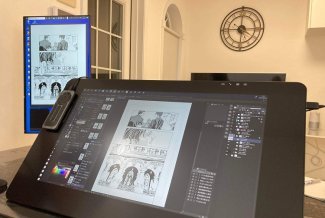An impending US Supreme Court decision threatens the right of public employees to union representation and collective bargaining, and it is a decision that will “hit every public-sector worker across this country,” says Corey Upchurch, a school bus driver for special needs children in Washington DC.
“Just imagine if money is taken off your table, or you’re not able to send your child to college or you not able to retire because you don’t have a pension,” says Upchurch, a father of three children, ages 16, seven and five. “That’s what this case is trying to do.”
Upchurch was amongst thousands of US public employees and their allies who rallied in the US capital this past weekend to demand the High Court respect fundamental worker rights. The Court’s decision will directly affect nearly 18 million public sector workers, disproportionately impacting African-American women – who make up 17.7 percent of public employees. African-American women are paid only 65 cents of the dollar that their white male counterparts are paid – and unions help reduce this pay gap.
The issue involves “agency fees,” which are deducted from paychecks to cover the costs of union representation. The case was brought by an Illinois public worker, Mark Janus, against his union, the American Federation of State, County and Municipal Employees (AFSCME), and is part of a larger corporate attack on freedom of association in the United States and, more broadly, around the world.
“The loss of agency fees threatens to trigger an insidious free rider dynamic in which some workers avoid paying for the union’s representation thus weakening the union’s ability to defend the workers it represents, which in turn will discourage others from paying, perpetuating a destructive cycle that quickly undermines union strength,” says Joseph McCartin, executive director of the Kalmanowitz Initiative for Labor and the Working Poor at Georgetown University.
Corporations fuel attacks on public employees
Janus is represented pro bono by a wealthy legal foundation with connections to funding by the notoriously anti-union Charles Koch Institute. Similar attempts to gut public employee unions also have been initiated and funded by other extreme anti-union organisations in a decades-long coordinated assault on freedom of association in the United States.
“Fifty years ago, Martin Luther King paved the way for fair wages, and now CEOs and the Koch brothers are trying to take our freedom and our rights away from us,” says Upchurch. The February 24 Working People’s Day of Action marked the 50th anniversary of striking African American sanitation workers’ first march with King in Tennessee.
Attacks on public employee rights around the world have increased in the past five years, with many countries establishing national laws restricting, and sometimes criminalising, the right to organise and strike, according to the global union, Public Services International (PSI). Privatisation of public services is another means by which governments and corporations worldwide seek to break unions’ collective agreements, drive down wages and conditions, introduce precarious work and destroy unions.
“The potential profits from public services, combined with three decades of global neo-liberal propaganda, make public services a target for privatisation by corporate profit seekers,” according to PSI. Women, who comprise large percentages of public employment globally, are especially disadvantaged when public-sector jobs are gutted.
“This US case reveals the limitations of the ‘freedom of association’ paradigm internationally in the context of 21st century global capitalism,” says McCartin.
“The hyper-mobility of capital and the increased competition of worker against worker in the global economy ensures that the mere freedom to associate is no freedom at all if those who come together are denied the ability to build strong, self-sustaining associations that are capable of addressing the issues that have drawn them together in the first place,” he says.
Attacks on public employees and their unions and on freedom of association in general are part of widespread global assault on democratic institutions. As pointed out in a 2015 report by the then-UN special rapporteur on freedom of association and assembly Maina Kiai, the freedom to join unions and peacefully assemble are “the gateway to all other rights; without them, all other human and civil rights are in jeopardy.”
While union membership in the US private sector has decreased in recent years, with only 6.5 percent of private-sector U.S. employees in unions, the percentage of public employees in unions is on the rise, with unions representing some 38 percent of public employees in 2017. As union membership grows, “union-busters are turning to the Supreme Court to obstruct union organising,” says Sharan Burrow, general secretary of the International Trade Union Confederation (ITUC).
“We hope that the Court will rule in favor of ordinary people, not the vested interests of the ultra-rich,” she says.
The Ramifications of Janus for US Workers
The United States has not ratified core International Labor Organization (ILO) conventions on worker rights, including the Freedom of Association and Protection of the Right to Organize Convention (No. 87) and the Right to Organize and Collective Bargaining Convention (No. 98). The country operates a framework that “legalizes practices that severely infringe workers’ rights to associate,” according to a 2016 report on the United States by the United Nations special rapporteur on the rights to freedom of peaceful assembly and of association.
In this already difficult environment for freedom of association, a ruling in favour of Janus could make the public sector “right-to-work”. The term “right-to-work” was coined decades ago by union opponents who first pushed for state laws prohibiting the requirement that employees in unionised workplaces pay union dues, even though they benefit from the higher wages and other improved conditions negotiated by the union. (In the United States, employees in similar classifications at a specific worksite are represented by a single union.) Right-to-work states’ unionisation rate is less than half the rest of the country’s. The UN special rapporteur’s report called “right-to-work” laws “a violation of workers’ right to freedom of association under international human rights law.”
McCartin offers the example of Wisconsin, where Governor Scott Walker in 2011 pushed a law that eliminated agency fees in that state. “Union density was nearly halved within five years, paving the way for the enactment of a “right-to-work” law in the state in 2015,” he says, noting that a negative outcome for workers in Janus could result in similar moves in more than 20 states, including union strongholds such as New York and California.
Anti-union forces do not plan to step back even if they win. Matt Patterson, who ran anti-union campaigns for the nonprofit Americans for Tax Reform, plans to launch a group that will use ads and door-to-door canvassing to convince union members not to pay dues, according to Bloomberg Businessweek.
But no matter the outcome, public employees and their unions plan to maintain the massive mobilization they and their unions launched in the face of the Janus case. AFSCME, the American Federation of Teachers and other public sector unions have been making one-on-one contact with members over the past few months to discuss the implications of Janus and reinforce the value of their union representation.
For public workers across the country, “now is the time for our voices be heard,” says Upchurch.
“We have to show strength, we have to show unity, we have to show no matter what comes out of this case, we’re gonna fight.”









